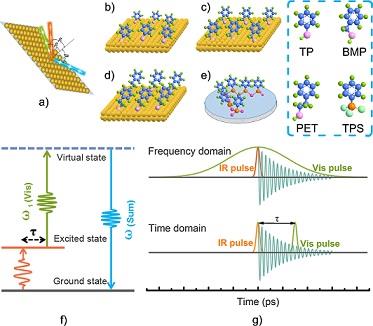作者:Pengcheng Hu, Xu Li, Bolin Li, Xiaofeng Han, Furong Zhang, Keng C. Chou, Zhan Chen,* and Xiaolin Lu*
關(guān)鍵字:Coupling, Fs-SFG, Quantum beating, FID
論文來源:期刊
具體來源:J. Phys. Chem. Lett., 2018, 9 (17), pp 5167–5172
發(fā)表時間:2018年
在本文中����,我們用量子拍頻的方法解析了飛秒和頻振動光譜(Fs-SFG)中時域和頻域的光譜�,得到了振動能量自由衰減對應(yīng)的馳豫時間,首次用Fs-SFG區(qū)分了與電子振動耦合以及未耦合的苯環(huán)碳?xì)渖炜s振動�����。相關(guān)技術(shù)可應(yīng)用于微納光學(xué)器件和分子器件的機制研究����。由于振動馳豫反應(yīng)了分子堆集的緊密程度,從基礎(chǔ)科學(xué)層面�,后續(xù)我們希望將這項技術(shù)應(yīng)用于區(qū)分生物和高分子界面不同微環(huán)境的研究中。
感謝文章中多位同學(xué)對這一重要基礎(chǔ)科學(xué)研究的貢獻����。胡鵬程、李柏霖和韓曉鋒教授在實驗操作上的貢獻��,胡鵬程��、李旭����、張芙榮、Chou教授對飛秒數(shù)據(jù)處理和程序?qū)懽魃系呢暙I。感謝與Chou教授和Chen教授的討論��。正是與所有人的討論讓我們對飛秒技術(shù)有了逐步加深的認(rèn)識�。同時證明,依靠我們自己的努力��,我們可以在非線性光譜和界面交叉領(lǐng)域做出重要的工作��。
https://pubs.acs.org/doi/abs/10.1021/acs.jpclett.8b01765
https://pubs.acs.org/doi/suppl/10.1021/acs.jpclett.8b01765/suppl_file/jz8b01765_liveslides.mp4


Molecular couplings at interfaces play important roles in determining performance of nanophotonics and molecular electronics. In this letter, using femtosecond sum frequency generation (fs-SFG) to trace free-induction decay (FID) of vibrationally excited aromatic thiol molecules immobilized on metal with and without the bridged methylene group(s), metal surface free electron-coupled and uncoupled phenyl C-H stretching vibrational modes were identified, with dephasing times to be ~0.28 ps and ~0.60 ps, respectively. For thiols on Au with the bridged methylene group(s) (benzyl mercaptan and phenylethanethiol), both the coupled and uncoupled modes were observed; for thiol on Au without the bridged methylene group (thiophenol), only the coupled mode was observed. This indicates that the bridged methylene group(s) serving as a spacer can be used to adjust the molecular coupling between the phenyl vibration and surface free electrons. The experimental approach can be used to tune molecular couplings in advanced nanophotonics and molecular electronics.